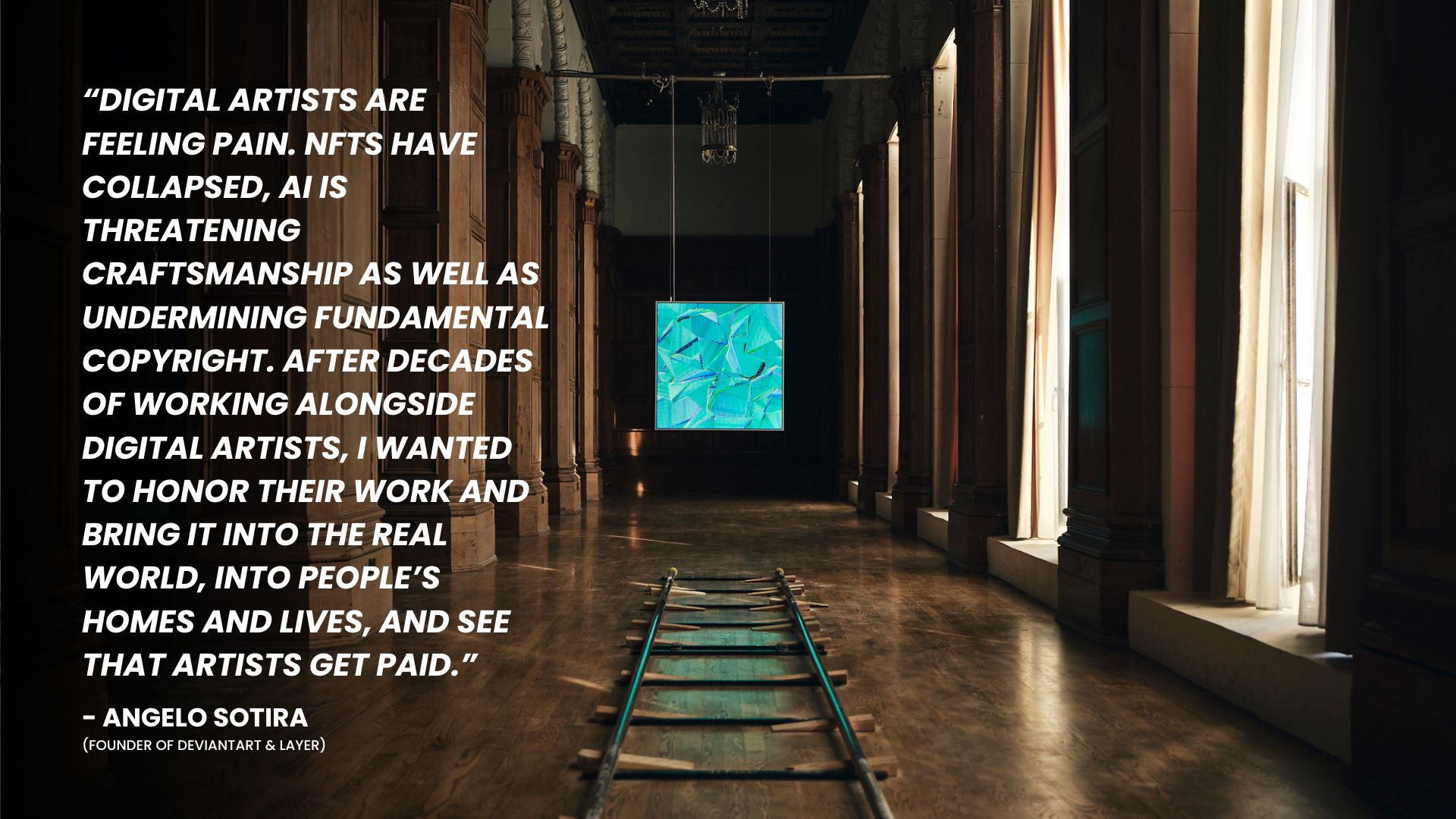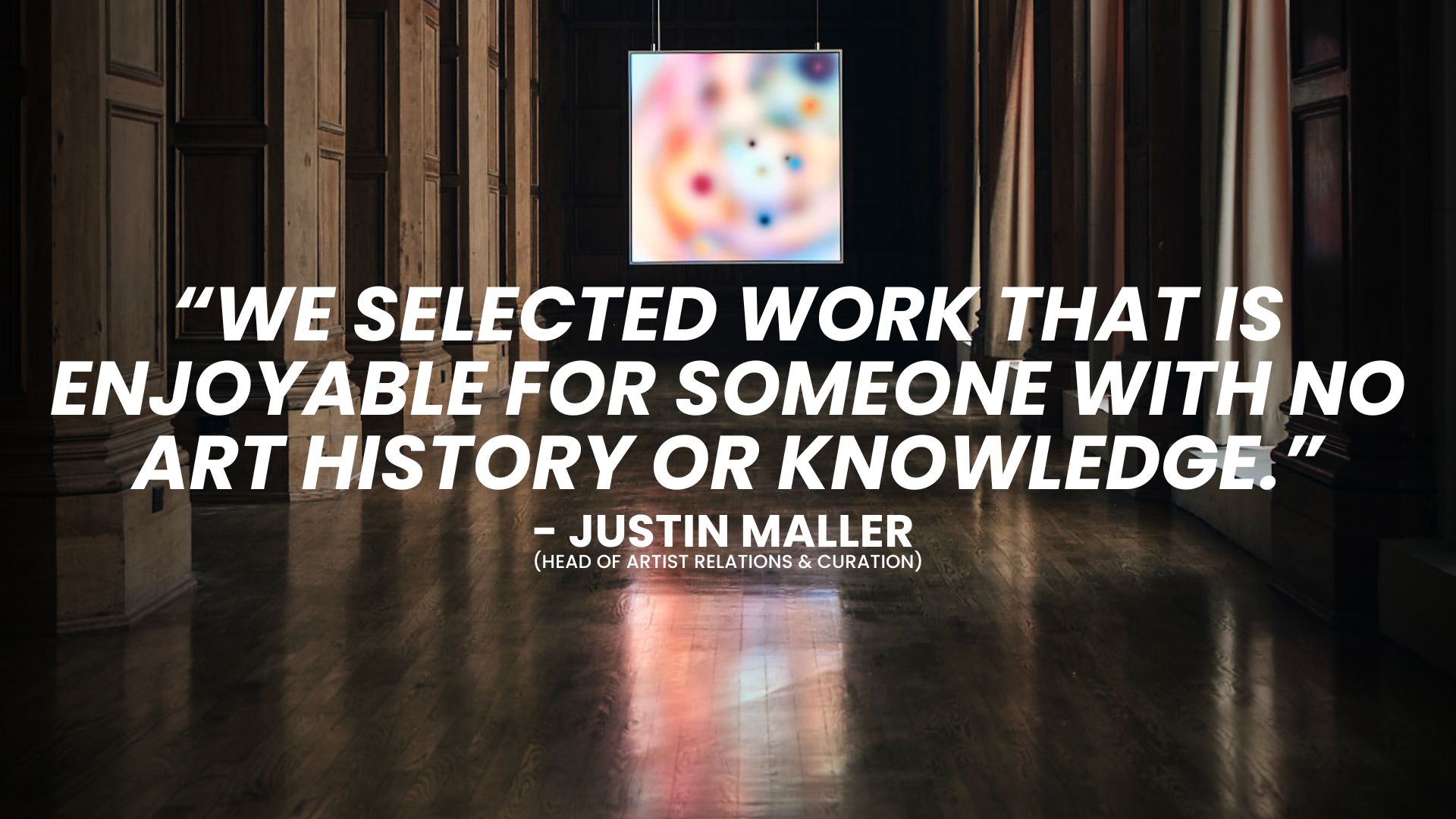Whitehot Magazine
December 2025
"The Best Art In The World"
"The Best Art In The World"
December 2025
A New Canvas, a Narrower Frame: Inside Digital Art’s Luxury Makeover
 "Still Life" by Casey Reas
"Still Life" by Casey Reas
A digital landscape breathes to life, brush strokes gently moving as if stirred by wind. Thick, painterly light floats just beneath the surface.
The colors of the Layer Canvas aren’t backlit like a tablet or TV. They emit rather than glow. Consumed, I want to reach out and touch it, half-expecting texture.
"It's not a touchscreen," says Angelo Sotira, "Layer is a canvas dedicated to art. Any adjustments are possible only via the Layer app."
Sotira, founder of Layer, hands me a small tablet. Here, I can scroll through a gallery of digital artworks selected by a curatorial board. They have forged partnerships with the biggest names in generative and pixel-based media: Zach Lieberman, Casey Reas, Leander Herzog, and more.
Meeting Sotira feels a bit like meeting the architect of my hometown. As the founder of DeviantArt, once the world’s largest community for digital artists, he helped build the internet ecosystem where my generation of creatives first found an audience.
As I toggle the frequency and saturation of the images, the teenage version of me wonders how we got here. It’s difficult not to look for flashes of Sotira's past work building the chaotic, inspiring, sometimes toxic, always alive corner of the internet where I found my love for art.
Sotira is still a profound technical expert, rattling off details about the Layer Canvas’s ultra-resolution, GPU-powered display. He talks about creativity like energy in need of a proper container. To him, the Layer Canvas is proof that digital art is finally maturing into a collectible medium worthy of the private fine art market beyond crypto enthusiasts (but not exclusing the crypto enthusiasts who now make up a non-insignificant portion of gallery sales).
 "Untitled" by Zach Leiberman
"Untitled" by Zach Leiberman
Most of the displayed works are generative art produced from artist-authored code (human made, not AI). Despite its futuristic origins, output feels organic: non-figurative abstractions with bright gradients and biomorphic forms. The accompanying app includes artist biographies and contextual information for viewers to interact with, a virtual gallery assistant.
"We selected work that is enjoyable for someone with no art history or knowledge, and we provide background about the artist and the piece in the gallery,” explains Justin Maller, Layer’s Head of Artist Relations & Curation and former Chief Creative Officer at DeviantArt. Maller is himself a pioneer in new media, his own bright, geometric work helping define what many now think of when they hear the term "digital art."
"You can find beauty and a bit of yourself, experimenting with what resonates and what doesn't." Maller says, flipping through the app’s catalog of artist descriptions. The platform is built not just to display art but to cultivate cultural fluency among collectors.
The Layer is hypnotic. The room around it quiets. It doesn’t flicker or perform; it simply exists… calm, contained, intentional.
"We expect that, eventually, most people will get lost in a few of their favorite generative pieces most of the time," Sotira explains, his voice pulling me out of the work. "But it's also nice to be able to showcase a variety of works while entertaining."
A lifelong creative technologist, Sotira is wise to aim at the luxury market for his next chapter. The built-in subscription curation model offers steady revenue to support artists, relying on scarcity and exclusivity without the hype or volatility of NFTs. It also opens new opportunities for innovation in display and presentation by treating digital art not as ephemera, but as an essential part of contemporary cultural interiors.
Collectors benefit, too. The Layer Canvas eliminates the cost and hassle of shipping and reinstallation, and Layer connects buyers to vetted, local white-glove installers with fine art credentials.
“I’ve spent my career sending pixels across the globe. But building delicate physical technology—that’s a whole different challenge,” Sotira says. Some of Sotira's early success came from the open-access ethos of DeviantArt, which offered both visibility and viability for digital creatives. In the official press release, Sotira writes, “Digital artists are feeling pain. NFTs have collapsed, AI is threatening craftsmanship as well as undermining fundamental copyright. After decades of working alongside digital artists, I wanted to honor their work and bring it into the real world, into people’s homes and lives, and see that artists get paid.”
These views have been consistent throughout his career. In a Forbes interview from over a decade ago, Sotira said: “My team and I are heavily focused on accessibility in the arts... We know that with technology today, in our lifetimes we’ll be able to make the lives of artists easier.”
Sotira has a great track record of improving material conditions for artists. Maller, once a volunteer administrator on DeviantArt, is living proof of that mission. With the possibility to go from anon mod to unicorn startup CCO, the art-tech space does create opportunitites for mobility when those at the top choose to keep the ladder open. Beside Maller lies a vast community of artists who leveraged the platform to earn income, hone their skills, or find purpose through art. For many, DeviantArt was an incubator, even if it never led to fame. Layer’s revenue-sharing model, where artists are paid in proportion to the time their work is displayed, hints at a more sustainable future now that the direct digital commission market has been irreparably altered by AI.
And now, as Sotira builds Layer, questions remain about who gets to come along for the ride. The website offers a space for "suggestions," explicitly not submissions. Far from the old days of the open internet, the sleek, formal submission form language offers a consolation to sensitive artists: "It's not personal. It's curation."
Layer represents a turning point in the story of digital art wherein aesthetics, economics, and technology converge to make digital work feel viable IRL. Sotira’s new canvas is more than a device; it’s a gesture toward permanence. For a generation raised on ephemeral digital platforms, the Layer Canva suggests that the screen, too, can become sacred. Whether it will serve as a bridge to broader opportunity or simply a showcase for the already successful remains to be seen. But as the work breathes, shimmers, and shifts on the wall beside me, I’m reminded of the promise that brought so many of us online in the first place: that art, when given the right frame, can change lives.

Ken Krantz
Ken Krantz is interested in the intersection of business, culture, and bravery where great artwork emerges. He can be found on Instagram as @G00dkenergy or online at goodkenergy.com.
view all articles from this author








